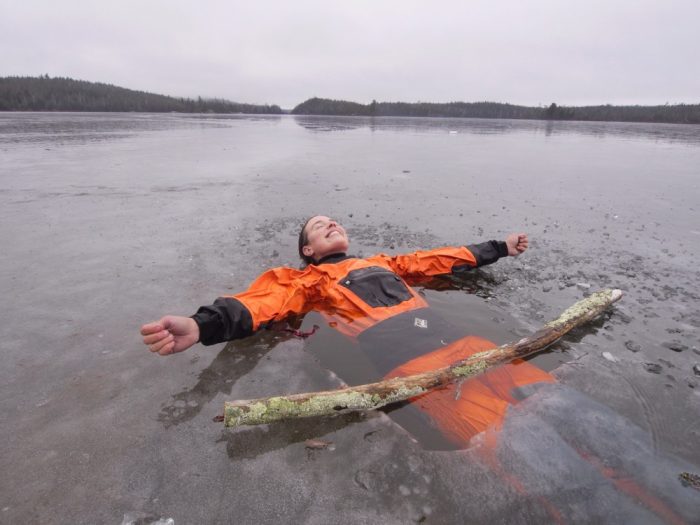[leadin]Adventurers Dave and Amy Freeman are spending a full year in the Boundary Waters of northern Minnesota, living in the wilderness and testing gear as a part of their daily existence. In this dispatch, Dave discusses spring ice out, a tricky time for backcountry travel in the BWCA.[/leadin]

As spring advanced and the ice started pulling away from shore, we found ourselves in a predicament. 90% of the ice was still safe to travel on and 10% was too rotten to walk on, or had melted away completely. We could no longer effectively travel with skis and toboggans, but the lakes wouldn’t be free of ice for at least several weeks.
An elder in the Northwest Territories once explained to me that the lakes and rivers were their roads. They needed to travel to gather food, hunt and trap. They couldn’t just sit around waiting for the ice to melt, so they just kept traveling.
With his words in mind, we decided to continue traveling as the lakes transitioned from solid to liquid. Along the way we learned that with a healthy dose of skill and caution, and the proper gear, ice-out is a magical time to explore. We found these 6 pieces of gear were essential during the shoulder seasons.
Drysuit
Immersion in near freezing water can quickly lead to disaster. A drysuit and proper layers of insulation are a safety item that I would not venture onto questionable ice without.

We have floated in icy water in total comfort while testing our drysuits, but after a couple minutes in the water without a drysuit you would be in serious trouble. During the fall and spring shoulder seasons we always wear a drysuit when we walk onto the ice.
Throw rope
We always carry a throw rope in case someone falls through the ice. A good throw rope with a throw bag allows you to toss a line to someone 50 feet away. We also are careful to not walk or stand near each other on questionable ice to reduce the risk of having multiple people fall through at the same time.
Axe
The ice can be a foot thick in one place and an inch thick a few feet away. An axe, chisel, or some sort of tool for assessing the thickness and quality of the ice is extremely important. You can stand on a couple inches of clear ice, but 6 inches of rotten, candled ice may not hold you. An axe or similar tool makes it easier to test the ice and get a sense of the quality of the ice.
Ice picks
We wear ice picks around our necks during the shoulder seasons. You can buy them, but ours are made of two 3- or 4-inch pieces of dowel rod with a sharp end of a nail sticking out of each one.

They are strung on the end of a rope to wear around our necks. Since ice is slippery you need picks to pull yourself up onto the ice if you break through. This is a last resort and preventing yourself from falling through is really key. Pulling yourself up onto the ice can be very difficult. Practicing this in a controlled situation is a good idea before heading out on a trip where there is potential for falling in.
Grippers
When the ice is barely strong enough to hold our weight we use a technique that we like to call Boundary Waters bobsledding to propel ourselves across the surface. The person in the front sits in the canoe and the person in the back runs along pushing the canoe while keeping their hands and most of their weight on the gunnels. The added traction provided by grippers worn over our boots makes propelling the canoe across the icy surface much easier. We have been surprised to find no noticeable wear on the bottom of our ultralight kevlar canoe from traveling over the ice.
Sturdy Paddles
Propelling a canoe up onto ice that is thick enough to hold our weight, or push our way though thin our rotten ice requires strong paddles. Sometimes we find ourselves literally canoeing over the ice, basically pushing the canoe over the ice with our paddles. Other times we are bashing at the rotten ice with our paddles to break a path. We have found strong paddles are really important.

These are some of the special pieces of gear that have helped us travel during the shoulder seasons. However, there are real risks associated with traveling over questionable ice. Nothing scares me more than bad ice. It has taken many years of paddling and traveling over and through ice to gain the skills and experience that allow us to travel during the shoulder seasons with a level of risk we feel comfortable with. Please use extreme caution if you choose to venture out on questionable ice, cold water is a harsh teacher.






